Mushrooms – There are about 10,000 named species in North America, which comprise only a third or a fifth of all existing mushrooms. Some are edible, while others are considered poisonous and some other species have medicinal or hallucinogenic properties. They occur worldwide, in many different shapes, sizes and colors. However, the ultimate goal of the mushroom is to disperse its spores from the fruiting body. To achieve this, each mushroom grows and matures in its own particular way, and some species have such an unusual appearance (or even repulsive!) that they look like they belong to another planet.
Here are some of the most bizarre mushrooms and fungi that will leave you in awe, but may disgust you as well.
1. Phallus indusiatus (Veiled lady)
Phallus indusiatus, known by its common names bamboo mushrooms, bamboo pith, long net stinkhorn, crinoline stinkhorn or veiled lady, is a fungus in the family Phallaceae, or stinkhorns. It is distributed across southern Asia, Africa, the Americas, and Australia where it grows in woodlands and gardens in rich soil and well-rotted woody material.
The mature mushroom measures up to 25 cm (9.8 in) tall and is recognizable by a conical to bell-shaped cap on a stalk and a delicate net-like structure or lacy ‘skirt’ (known as indusium) that hangs down from the cap and almost touches the ground. The cap, measuring 1.5–4 cm (0.6–1.6 in) wide, is smooth at first and becomes pitted and ridged when mature. Its surface is covered with a greenish-brown and foul-smelling slime, the gleba, which attracts flies and other insects that eat the spores and disperse them. Phallus indusiatus is edible and used as an ingredient in Chinese haute cuisine, as well as utilized in Chinese medicine due to its antioxidant and antimicrobial properties.
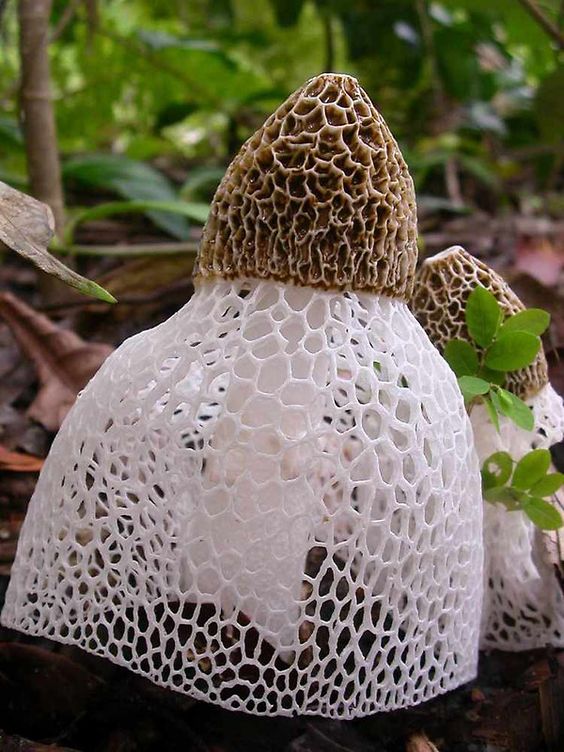
Credit: panvorax
2. Panus fasciatus (Hairy trumpet)
Panus fasciatus, commonly known as Hairy trumpet, is a common wood decaying fungus found on dead wood in forests and woodlands throughout southern and eastern Australia. It is easily identified by the densely hairy cap and chestnut bristles on the stem. The mushroom tends to dry out during warm weather, but can rehydrate after some rainy days. The cap is between 2–5 cm in diameter, flat or with a depressed center, light creamy brown, covered with coarse hairy scales. In young specimens, the margin of the cap is rolled under. The crowded gills extend down the stem, and when fresh, they have a purple tinge and become brown as they mature.
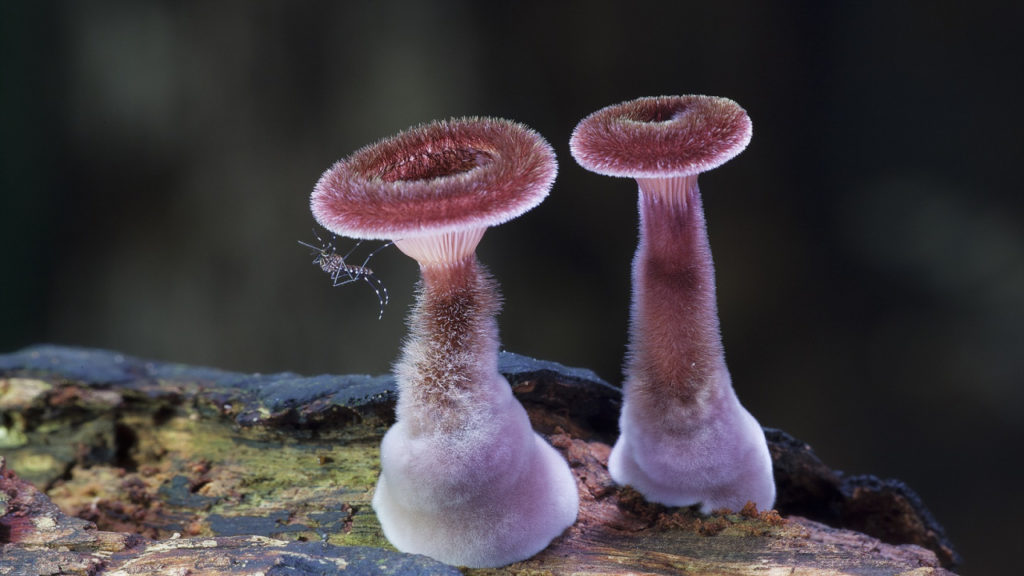
Credit: Steve Axford
3. Aleuria aurantia (Orange peel fungus)
Aleuria aurantia, known as Orange peel fungus, is a widespread ascomycete fungus found throughout mainland Europe, from Scandinavia to the Iberian Peninsula, and also in North America. It is a small to medium-sized mushroom and can grow to the size of a small orange. The bright orange, cup-shaped fungus often resembles discarded orange peel on the ground, giving this species its common name.
Initially, the cups are round, but soon develop wavy edges and have a tendency to split. This striking fungus varies in color from pale orange to a very deep orange-red inside the cup, while the lower (outer, in cup-shaped fruit bodies) surface is paler and covered in a very fine whitish down. Aleuria aurantia is considered as edible, but despite its attractive appearance, it is not particularly tasty and hence, rarely used in cooking except perhaps to garnish some food dishes or salads.
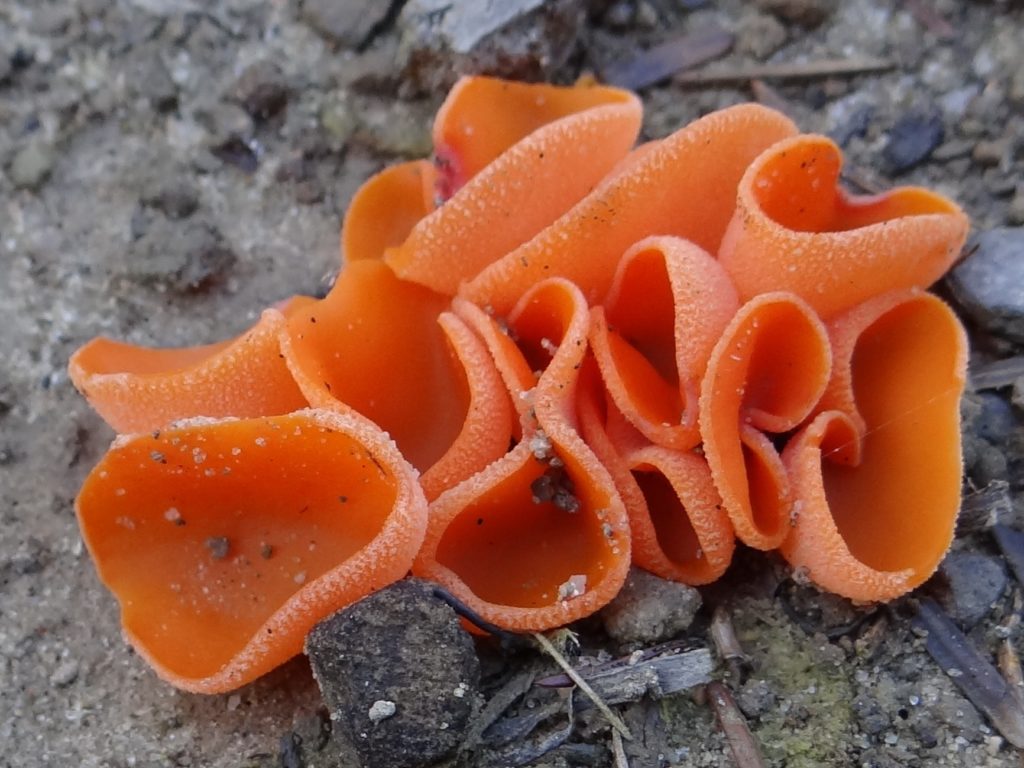
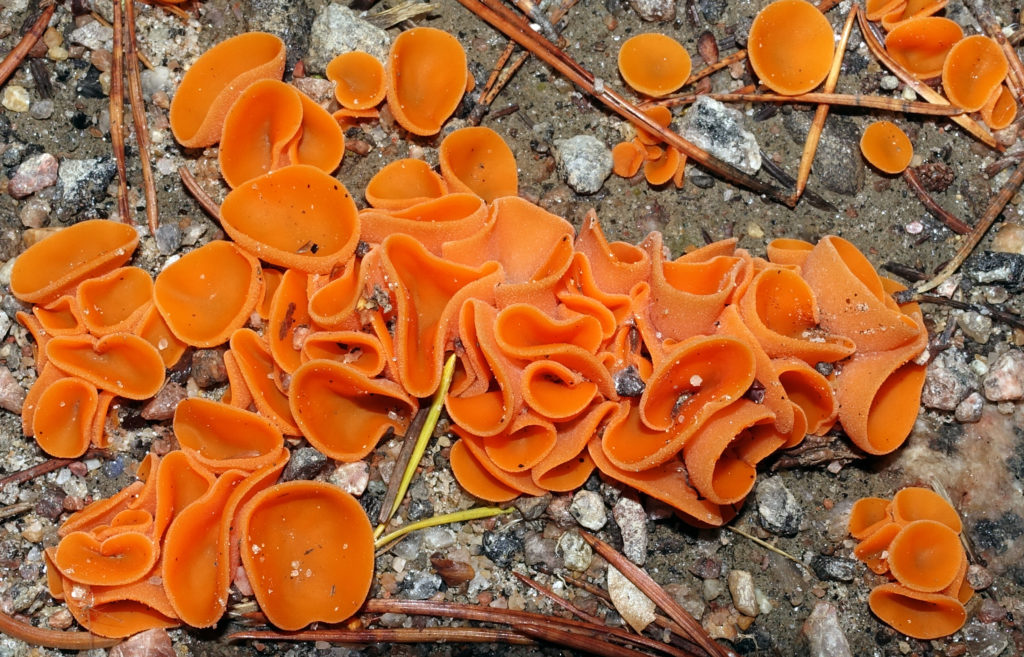
Credit: Tiia Monto via Wikimedia Commons
4. Laccaria amethystina (Aamethyst deceiver)
Laccaria amethystina, commonly known as the Aamethyst deceiver, is a small brightly colored mushroom, growing in deciduous and coniferous forests of Europe, Asia, Central, South, and eastern North America. The Amethyst Deceiver was first described in 1778 by the English botanist William Hudson, who named it Agaricus amethystinus. If you’re wondering about its common name, it’s due to its bright amethyst coloration which fades away with age and weathering, making it difficult to identify after that – hence the name “deceiver”.
This mushroom’s cap measures about 2 to 7 cm in diameter, and is initially convex and becomes almost flat-topped at maturity. During wet weather, the young caps are a deep purple in color while during dry spells, the caps and stems turn much paler to eventually almost white.
Read Also: Top 12 Insects With The Most Incredible Camouflage And Mimicry
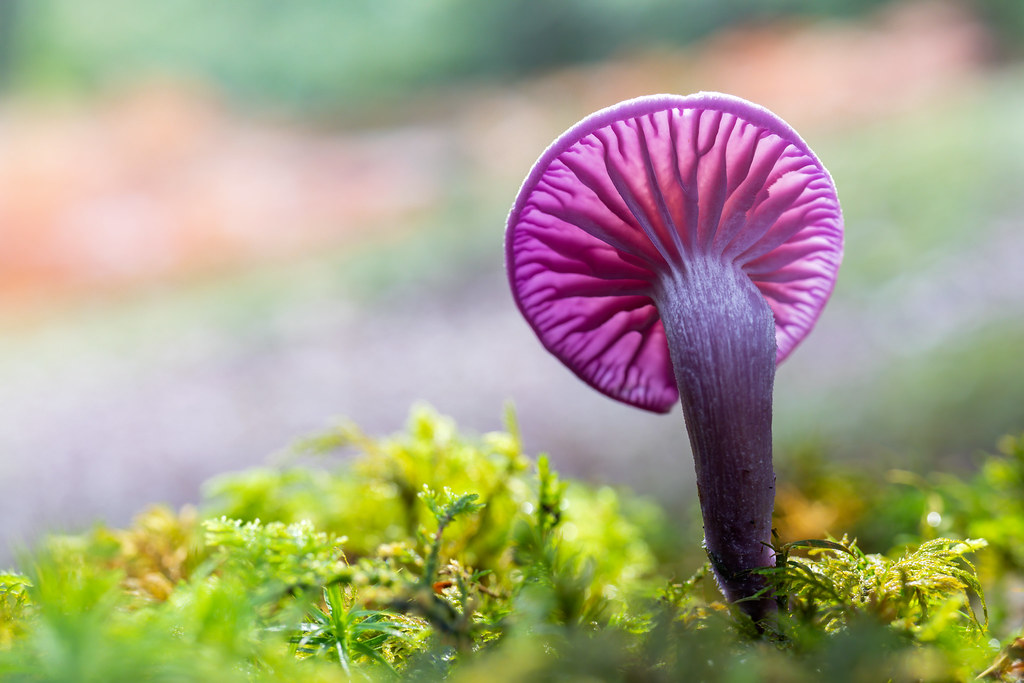
Credit: Eleanor Hilsdon

5. Coprinopsis atramentaria (Common Ink cap)
Coprinopsis atramentaria (Common Ink cap or Inky cap mushroom) is a widespread and common fungus found in Europe and North America. It is found in grassland, meadows, disturbed ground, and open terrain from late spring to autumn. Fruiting bodies have been known to push their way up through asphalt and even tennis courts. The Common ink cap can be up to 17 cm tall, with a conical grayish or brownish-gray cap and jet-black gills.
This mushroom has a particular method of distributing its spores. As it matures (often within 1-2 days), the gills ‘autodigest’ into a thick, black gooey liquid dripping from the edges of the cap, with the cap itself peeling up and away — a smart strategy for dispersing spores more efficiently. Historically, the Common ink cap was used to make ink for important documents. It would prevent forgery as the spores could be detected under a microscope. Despite its appearance, Coprinopsis atramentaria is edible, but it becomes poisonous if alcohol is consumed up to three days before and three days after eating it. This can give rise to symptoms such as facial reddening, nausea, vomiting, malaise, agitation, palpitations and tingling in limbs.

6. Xylaria Polymorpha (Dead man’s finger)
Xylaria polymorpha, commonly known as Dead man’s fingers, is a saprobic fungus which consumes the polysaccharides in timber, leaving behind soft, nutrient-rich debris on which many invertebrates feed. It is fairly common in the UK, Ireland, mainland Europe and parts of North America, and can be found in forest and woodland areas, usually growing from the bases of rotting or injured tree stumps and decaying wood.
It is recognized by its elongated upright, clavate, or strap-like stromata poking up through the ground, much like fingers, and with the fruiting body often appearing like burned wood. Fittingly named, these swollen, blackened ‘fingers’ reaching for the sky seem as if someone buried under the woodland floor is trying to make one final attempt at escaping. These macabre-looking fungus typically emerge in clusters of 3 – 6 swollen, warty ‘fingers’ that are often bent, and measuring 3 – 8 cm high. When young, they are pale gray with a whitish tip, and the flesh inside is white and tough under the black spore-bearing outer layer.
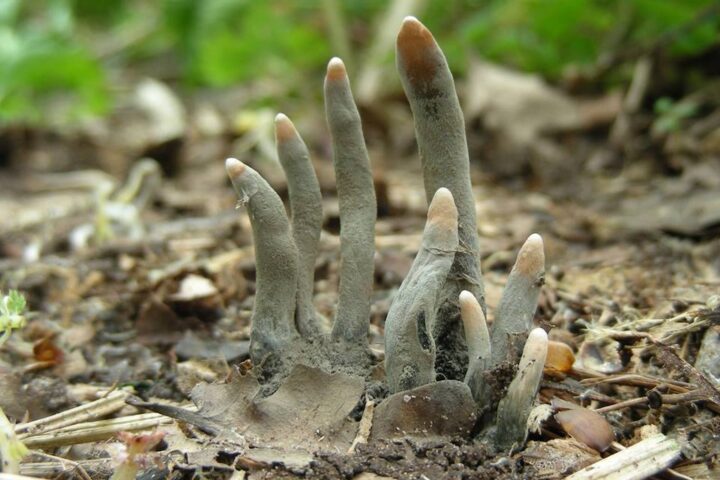
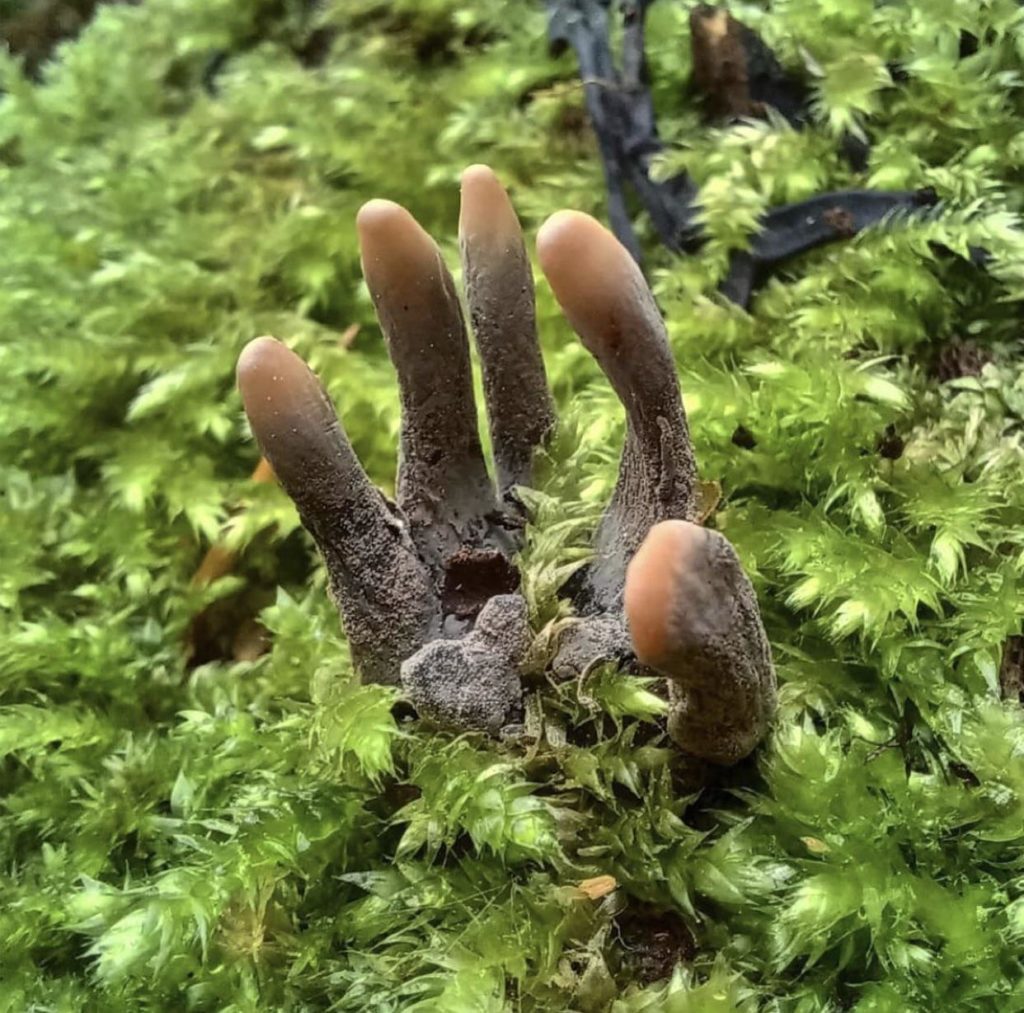
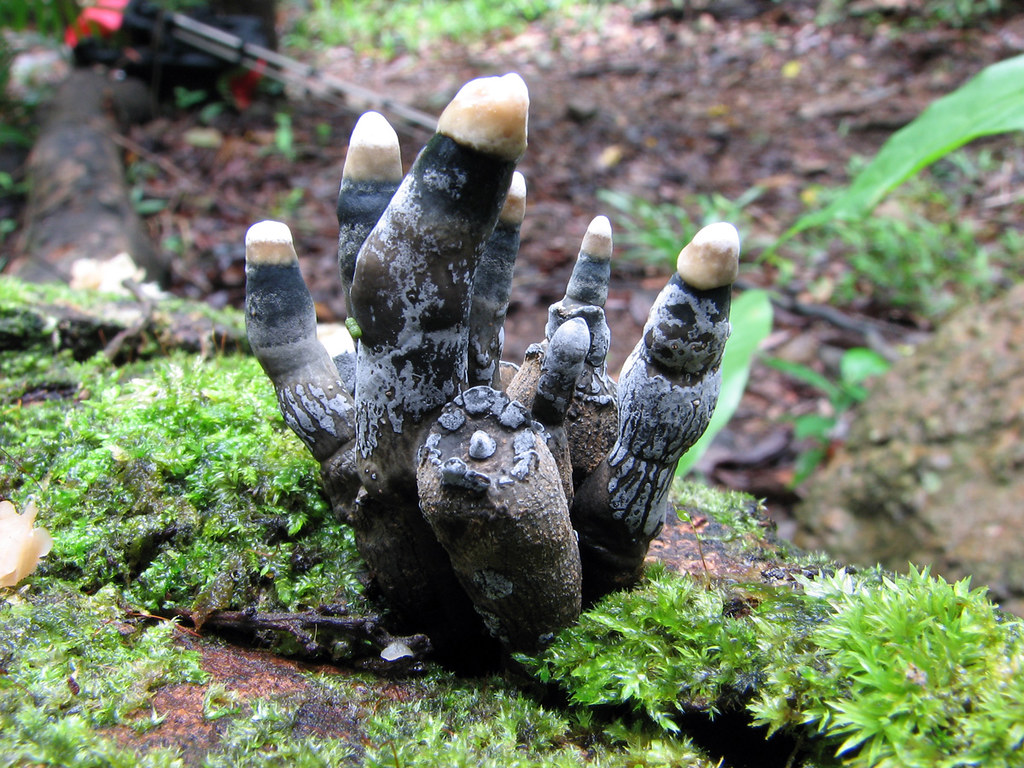
7. Hericium coralloides (Coral tooth fungus)
Hericium coralloides, known as the Coral tooth fungus, is a saprotrophic fungus and possibly somewhat parasitic. This delicately beautiful fungus normally fruits on dead hardwood logs and stumps or branches of hardwoods. Often, they are seen in massive patches that can be spotted from quite a distance. These fungi typically grow between 10 – 40 cm wide; and anywhere from 5 to 20 cm high.
They can be identified by their short spines (0.5 – 1 cm long) that hang in rows along delicate branches between 0.5 – 1 cm thick. These branches arise from a more or less central core that is attached to the wood. The fleshy spines (up to 1 mm wide), are white when fresh, and as they age along with the branches, they turn a light shade of yellowish brown. Hericium coralloides is widely distributed throughout North America and Europe, and also grows in India, Russia, China, and Japan.
An interesting fact: The Coral tooth fungus is also featured on a 2010 stamp from Belarus and a 2002 stamp from New Zealand.

Credit: jasana via Wikimedia Commons
8. Hydnellum peckii (Bleeding tooth fungus)
Hydnellum peckii is a fungus in the genus Hydnellum of the family Bankeraceae and is found in North America, Europe and was later discovered in Iran (2008) and Korea (2010). This fungus can reach a height of 4 in (10 cm) on average, but it has been seen to be as big as 8 in (20 cm). Due to its unusual appearance, it has several descriptive common names like strawberries and cream, the red-juice tooth, and the Devil’s tooth.
Young fruit bodies are covered in soft “hairs” that can give it a velvety texture, but these fall off as the mushroom matures. Also, young mushrooms are recognized by the “bloody” bright red liquid that oozes out through the pores, which has led these to be compared to “Danish pastry topped with strawberry jam”. This brilliant red gooey liquid is actually a sap caused by a process called guttation and occurs when the soil around the fungus’ root system gets wet and this forces water into the roots through osmosis. The pressure building up through the organism forces this liquid to the surface of the fungus, and it appears red due to a pigment found within the fungus. These red droplets contain a chemical compound, atromentin, which is similar to heparin and known to have anticoagulant properties as well as antibacterial properties.
As the fungus matures, the cap, which is initially whitish, turns to a gray or pinkish-brown color, and looks more like a normal mushroom. Despite its yummy pastry appearance, Hydnellum peckii is not particularly edible due to its extremely bitter taste, although it is not known to be poisonous.
Read Also: 37 Most Unusual Rock Formations From Around The World
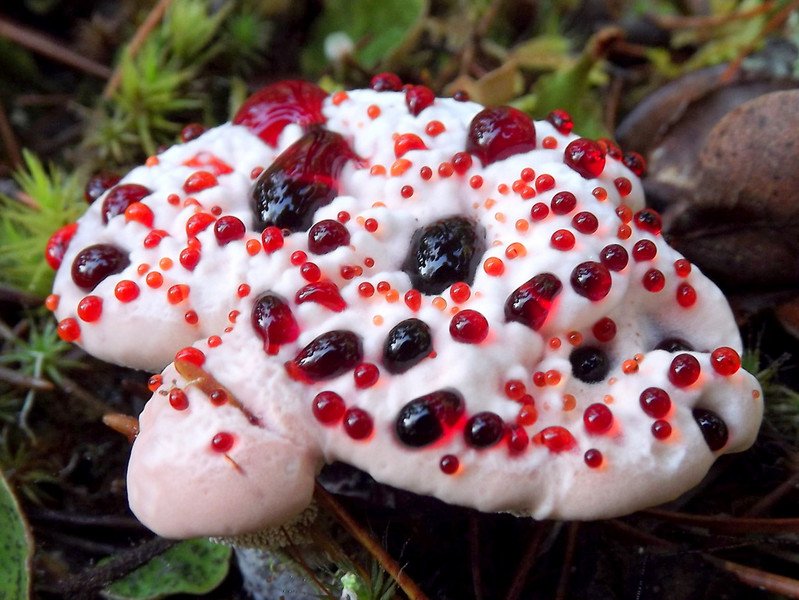
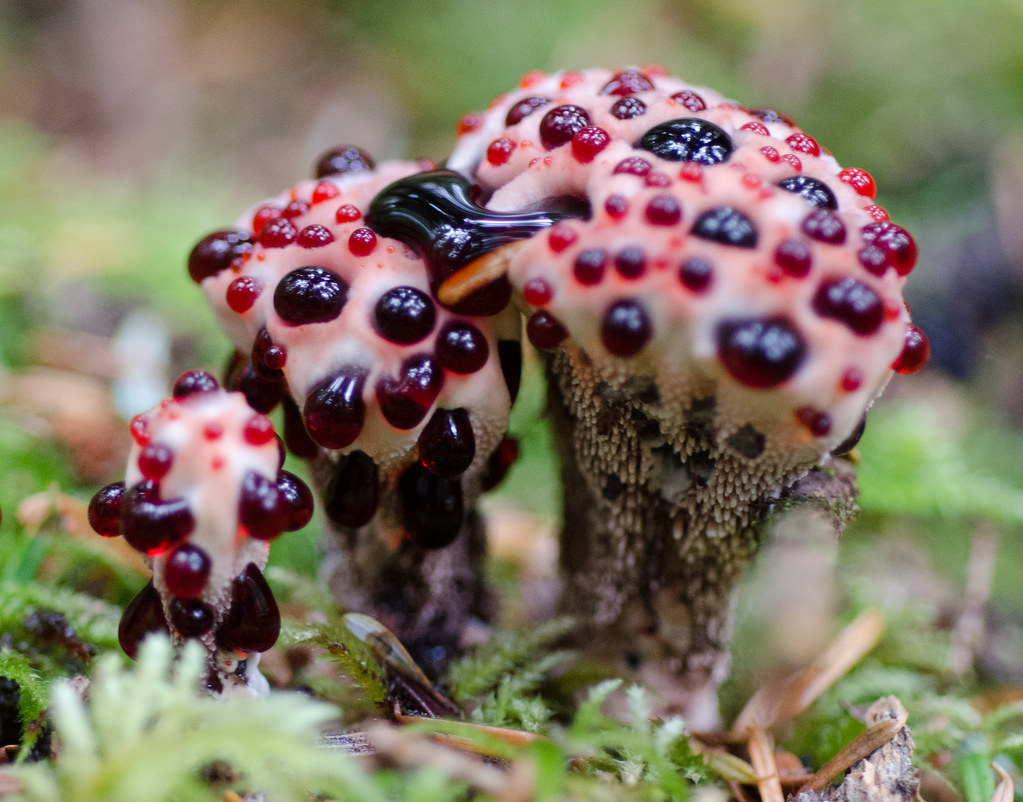

9. Microstoma floccosum
Microstoma floccosum is a species in the cup fungus family Sarcoscyphaceae. It is distinguished by its scarlet-colored, deep funnel-shaped fruit bodies covered by visible dense white hairs on the outer surface. This species is found in the United States and Asia, and grows scattered or clustered together on partially buried sticks and twigs, with a preference for oak and Shagbark hickory.
The cup is about 1 cm wide and 4 cm high, while the stem is cylindrical, and about 2 – 5 mm thick and 1 – 3 cm high. The rim of the cup bears a distinct fringe of white hairs. The stiff white hairs covering the exterior surface are up to 1 mm long or more, translucent, thick-walled and rigid. This fungus is widely distributed east of the Rocky Mountains (United States) and produces its distinctive fruiting bodies in the summertime. Microstoma floccosum is known to be inedible.
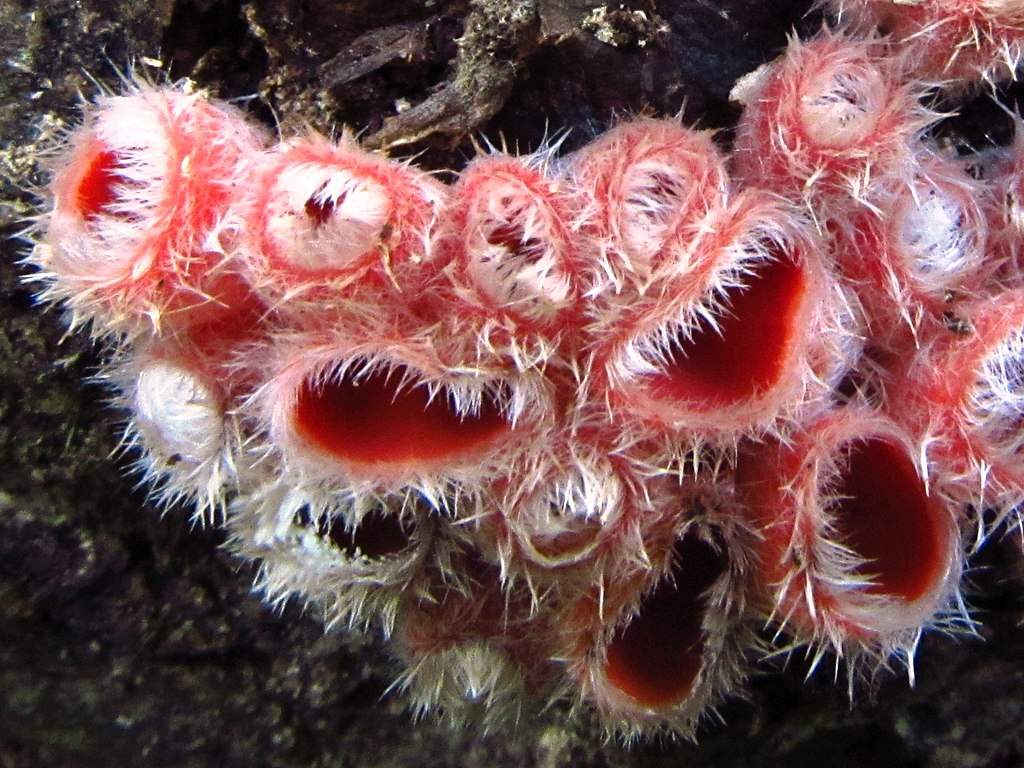
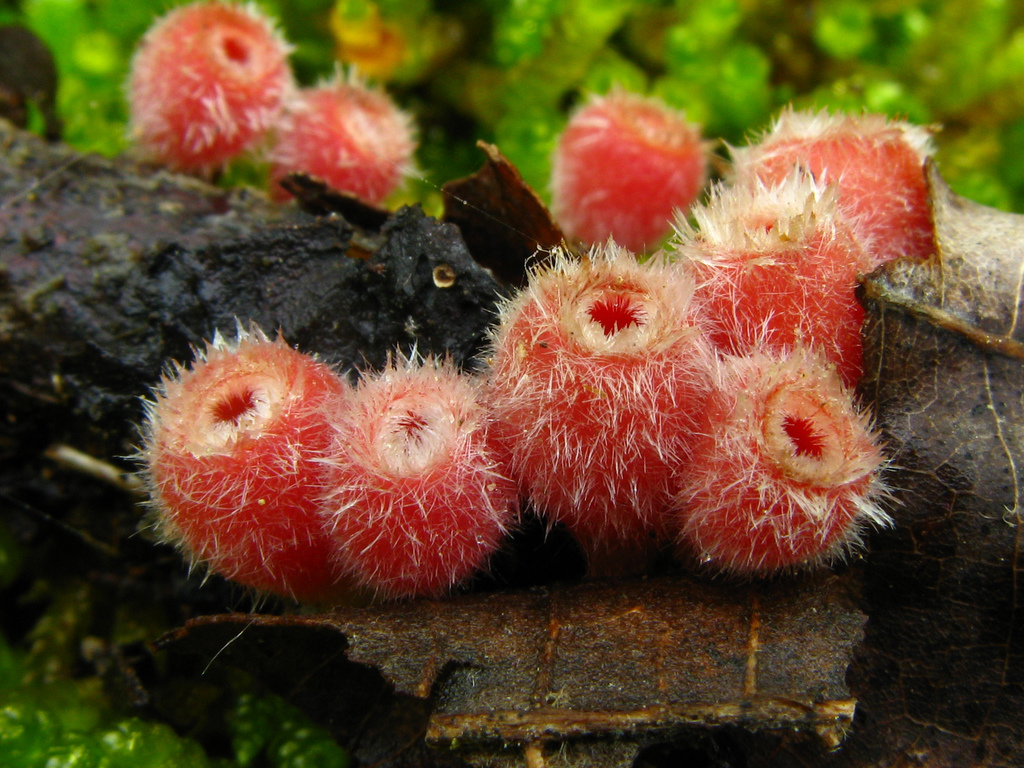
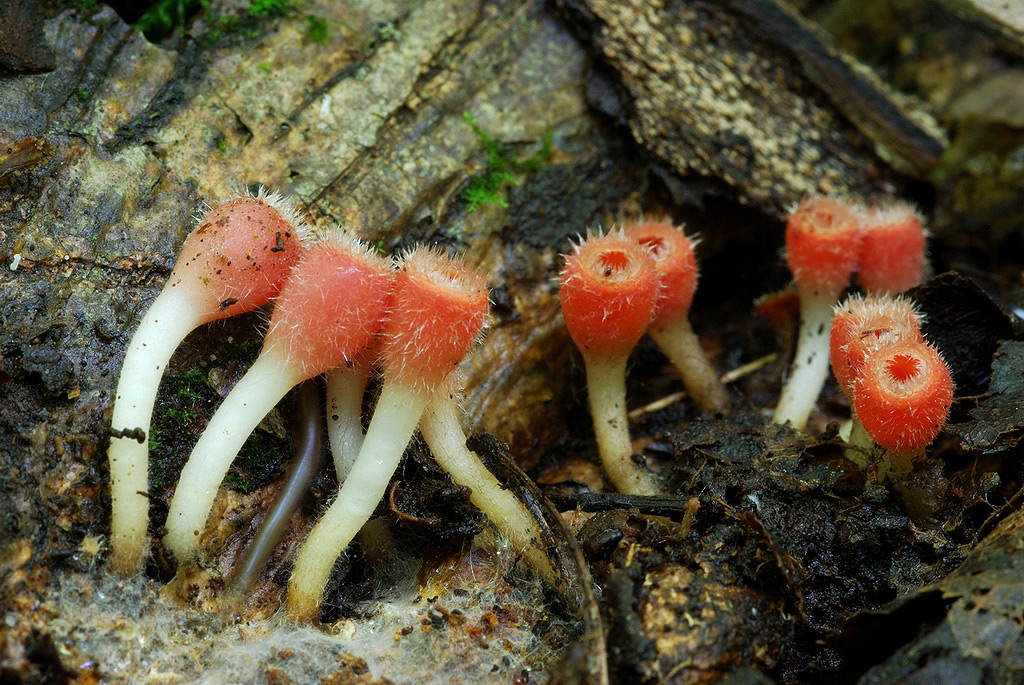
10. Gyromitra esculenta
Gyromitra esculenta is an ascomycete fungus from the genus Gyromitra, widely distributed across Europe and North America. This species grows on sandy soil in temperate coniferous forest and occasionally in deciduous woodlands. Gyromitra esculenta is a member of a group of fungi known as “false morels”, so named for their resemblance to the highly regarded true morels of the genus Morchella.
It can be distinguished by its irregular, brain-shaped cap that can reach 10 cm (4in) high and 15 cm (6in) wide, attached to a stout white stipe, up to 6 cm (2.5in) high. The cap color may be various shades of brown: reddish, chestnut, purplish, bay, dark or sometimes golden. Originally, the cap is smooth, but it becomes progressively wrinkled as it grows and ages, and it also darkens to black.
For centuries, these morel-like fungi have been collected and consumed by people in Scandinavia and Eastern Europe. However, they are potentially fatal if eaten raw, and although they are commonly parboiled before preparation, they still may not be completely safe for consumption, and the risk of poisoning exists. The toxin present in this fungus is named gyrotoxin, also known to be carcinogenic. Gyrotoxin affects the central nervous system and goes on to damage the victim’s liver and possibly also the kidneys.
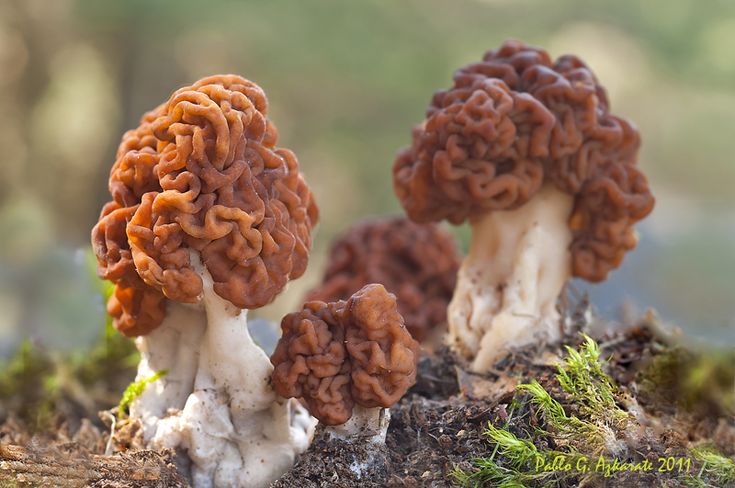
11. Ramaria araiospora (Red coral mushroom)
Ramaria araiospora, commonly known as the Red coral, is a coral mushroom in the family Gomphaceae. It is found in North America (coastal California and the Pacific Northwest), and the Himalaya, and the fruiting usually occurs in September and November. Fruit bodies grow on the ground singly or scattered, under conifers, especially western hemlock, and deciduous trees, particularly tanoak. The mushroom typically measures 5 – 14 cm (2 – 5.5 in) tall by 2 – 10 cm (0.75 – 3.9 in) wide. There is a single, somewhat bulbous stipe measuring 2 – 3 cm (0.75 –1.2 in) long by 1.5 – 2 cm (0.6 – 0.75 in) thick, which is branched up to six times.
Initially, the branches are red, and as they mature, they fade to a coral pink and eventually a lighter shade. The base, including the stipe, is white to yellowish-white and branch tips are yellow. When dried, fruit bodies turn to yellowish white in the base and dull red in the branches. Ramaria araiospora are edible, but can result in an upset stomach. These species are favored for their fleshy consistency, mild flavor, and abundance.

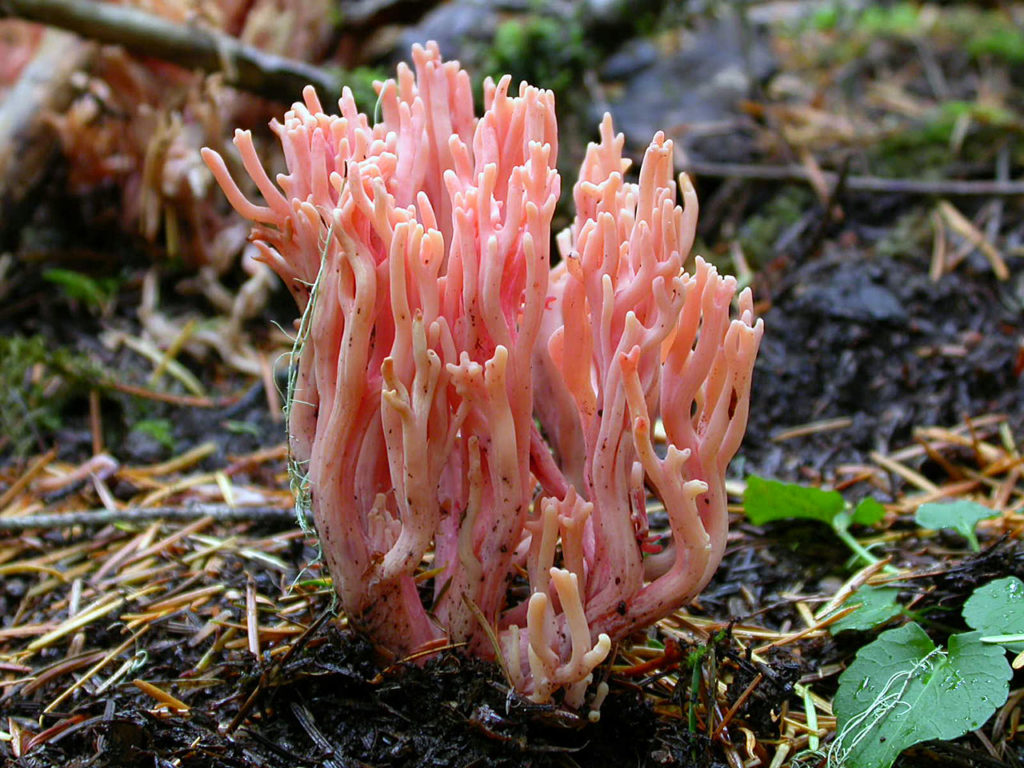
Credit: Ronald L. Exeter
12. Lycoperdon echinatum (Spiny puffball)
Lycoperdon echinatum, commonly known as the spiny puffball or the spring puffball, is a type of puffball mushroom in the family Agaricaceae. The saprobic species has been found in Africa, Europe, Central America, and North America, where it grows on soil in deciduous woods, glades, and pastures. This mushroom has a small spherical head supported by a very short stipe, densely covered with soft reddish-brown spines that are formed in groups of threes. The fruit bodies are 2–4 cm (0.8–1.6 in) wide by 2–3.5 cm (0.8–1.4 in) tall, with the spines measuring up to 0.6 cm (0.2 in) long.
The puffballs are initially white, but turn a dark brown as they age, and tend to lose their spines, leaving a net-like pattern of scars on the underlying surface. At the same time, their shape changes from nearly round to somewhat flattened. The internal contents of the puffball contain the gleba, a mass of spores and associated spore-producing cells. In young specimens, the gleba is white and firm, but as the puffball matures, it turns yellowish and then brown to purple-brown and powdery. The fruit bodies are edible when young, before the interior has turned into a powdery brown mass of spores. But it is necessary to remove the quills before consuming it.
Read Also: Top 12 Most Unusual and Creepiest Fish In The World
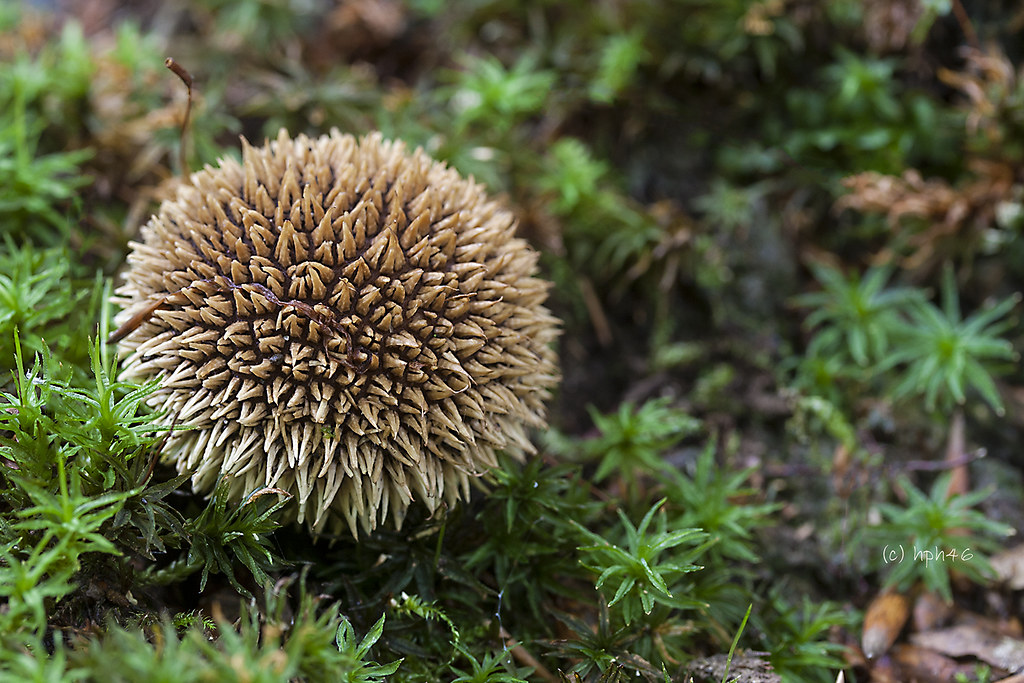

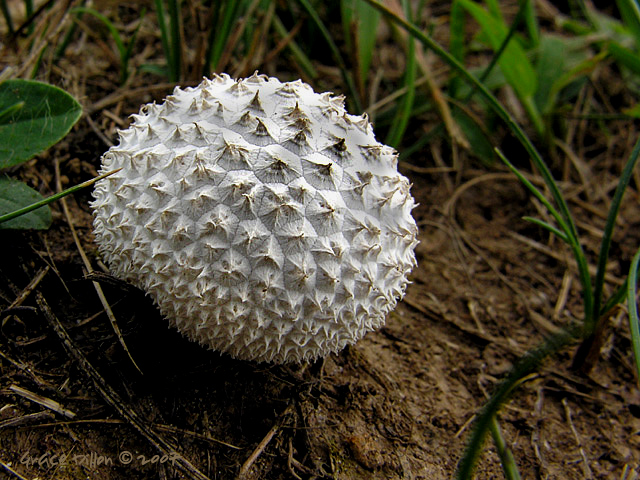
13. Favolaschia calocera (Orange pore fungus)
Favolaschia calocera, commonly known as the orange pore fungus, is a species of fungus in the family Mycenaceae. Its very particular appearance got it dubbed as Orange pore conch or even Orange Ping-Pong bat. F. calocera is a wood-inhabiting saprotrophic fungus. Throughout much of its expanded range, it is now considered an invasive species. It colonizes ruderal sites along transport routes and can become dominant in habitats disturbed by human activity.
Typically, it has a brilliant yellow color when fresh, and turns to a brownish yellow when dry. However, it often appears as a bright orange fan also. This striking fungus has a lateral stem of about 1.5 to 15 mm long and conspicuous pores on the underside, with larger ellipsoidal pores nearest to the stem and smaller more angular pores near the cap margin. The cap can be between 0.5 to 2cm across, with the infertile surface smooth when young, then developing undulations in a similar pattern as to that of the pores on the fertile surface
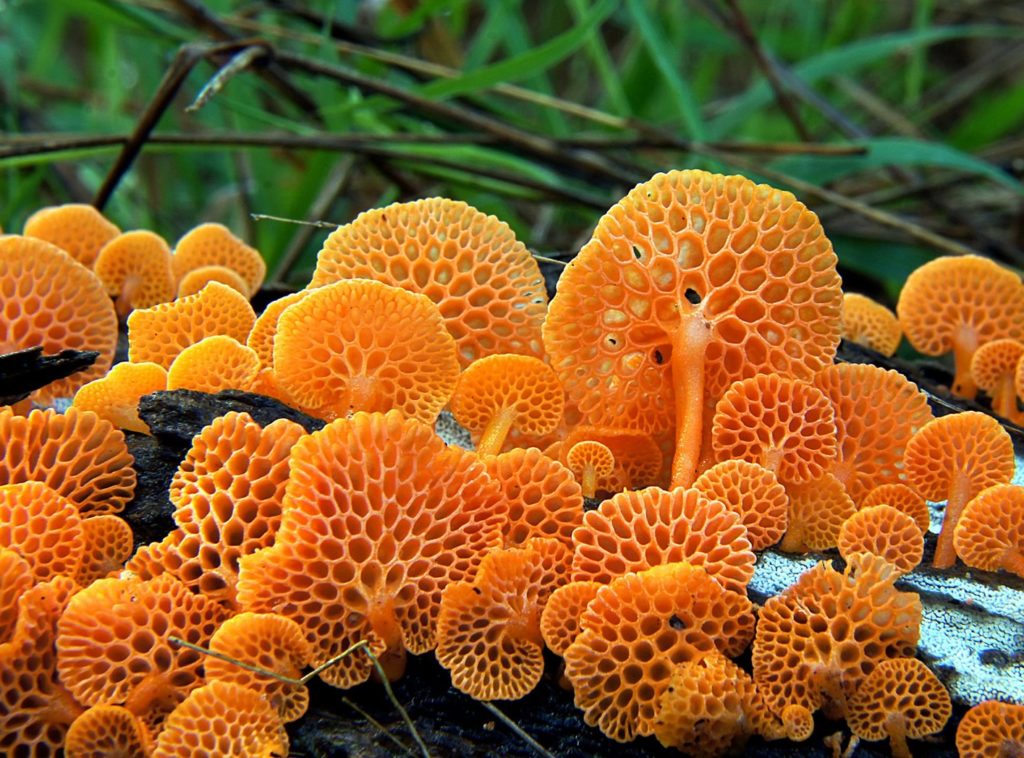
14. Rhodotus Palmatus (Rosy veincap)
Rhodotus palmatus is a mushroom species in the fungus family Physalacriaceae. It is known by its common names, the netted rhodotus, the rosy veincap, or the wrinkled peach. It occurs in eastern North America, northern Africa, Europe, and Asia, but due to its declining population in Europe, it has appeared in over half of the European fungal Red Lists of threatened species. Rhodotus palmatus can be found growing on the stumps and logs of rotting hardwoods. Variations in size, shape and cap color of the fruit bodies may occur as a consequence of the lighting conditions experienced by the mushroom during its development. Therefore, the color may range from salmon-orange to pink to red.
The cap, 2 – 6 cm (0.8–2.4 in) in width, initially assumes a convex shape before flattening somewhat with age, and the internal flesh is firm but rubbery. The edges of the cap are rolled inwards and itsgelatinous surface usually comprises a conspicuous network of lightly colored ridges or veins that display deep and narrow grooves or pits. The gills are thick, closely packed together, with veins and color similar to, but paler than, the cap. In the wild, Rhodotus palmatus is sometimes seen exuding a red or orange-colored liquid. The edibility of this species is typically listed as unknown or it is considered as inedible.
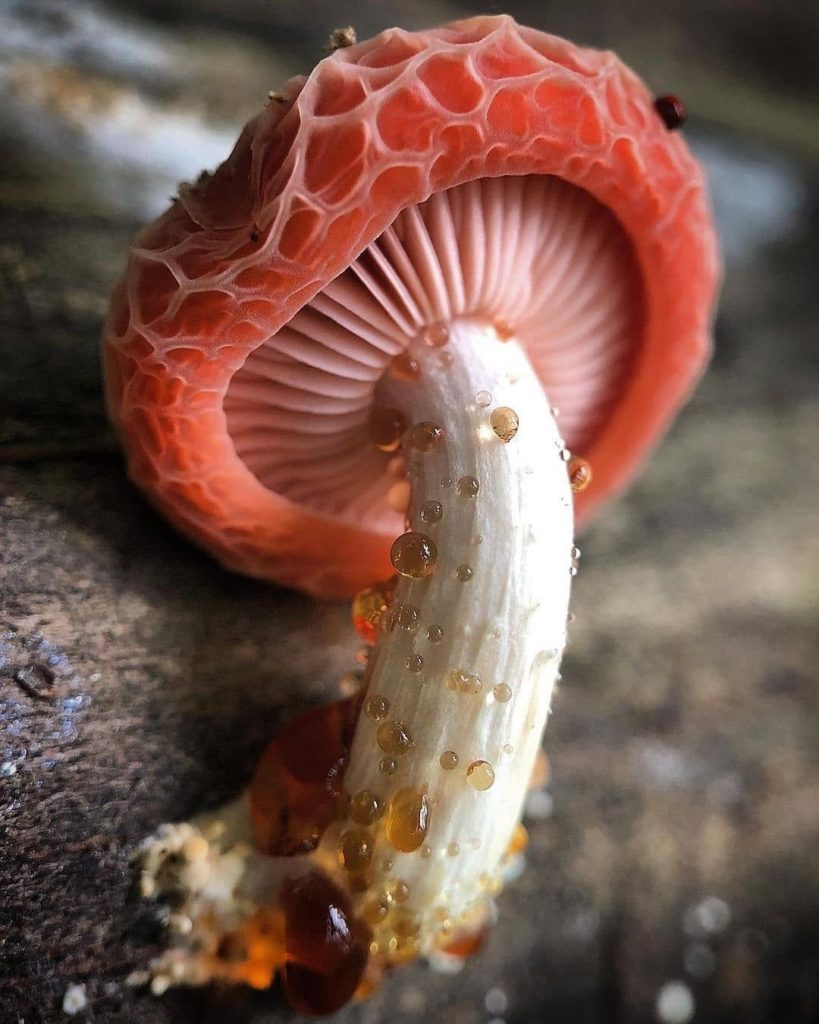
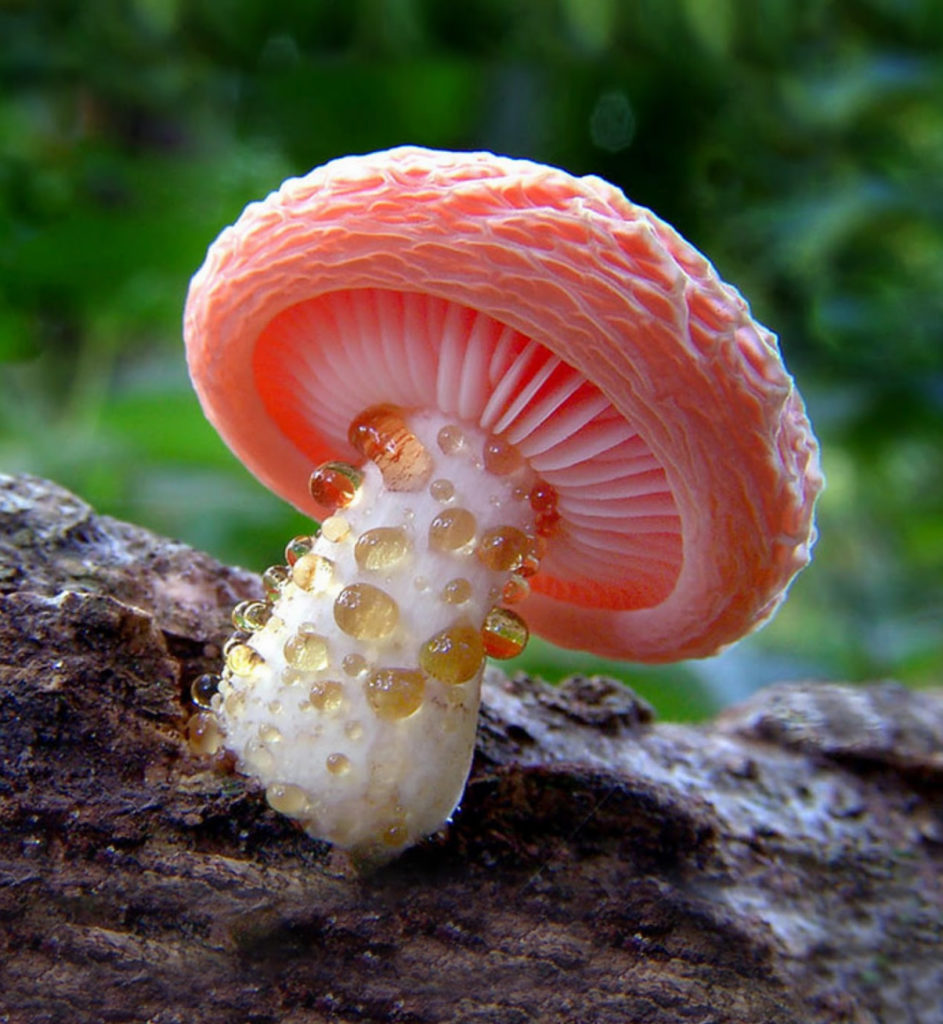

15. Clathrus archeri (Octopus stinkhorn or Devil’s fingers)
Clathrus archeri, commonly known as Octopus Stinkhorn or Devil’s Finger, is a fungus indigenous to Australia and New Zealand, and which has been introduced in Europe, North America, and Asia. In Britain, this unusual fungus is commonly known as Devil’s Fingers, and in parts of the US, it is referred to as the Octopus Fungus. Clathrus archeri is saprobic and mainly found in leaf litter under trees and shrubs; also increasingly on bark mulch in parks and gardens.
Similar to the common stinkhorn and the dog stinkhorn, this fungus emerges from a partly buried white ball or egg (between 2 – 3 cm in diameter), with 4 to 7 elongated, slender arms initially erect and then spreading out. These arms, when unfolding, reveal a pinkish-red interior covered with a dark-olive spore-containing gleba, making it accessible to insects – means by which the spores are distributed. The mature fruitbody, measuring 20 cm across with arms arching to 10 cm in height, has a putrid smell reminiscent of rotten meat.The Devil’s Finger fungus, which emerge from a “suberumpent” egg, has been likened to an alien creature being born.
Read Also: Lithops, An Unusual Succulent That Look Just Like Smooth Colorful Pebbles

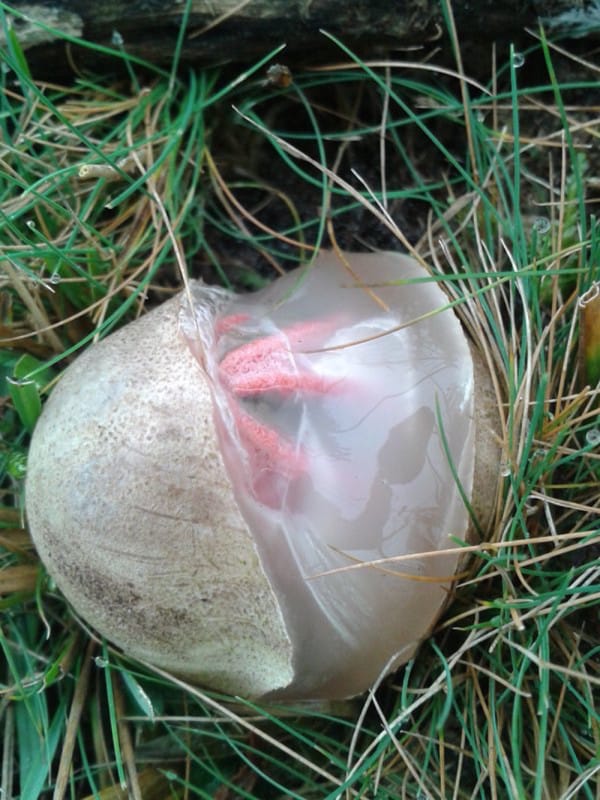
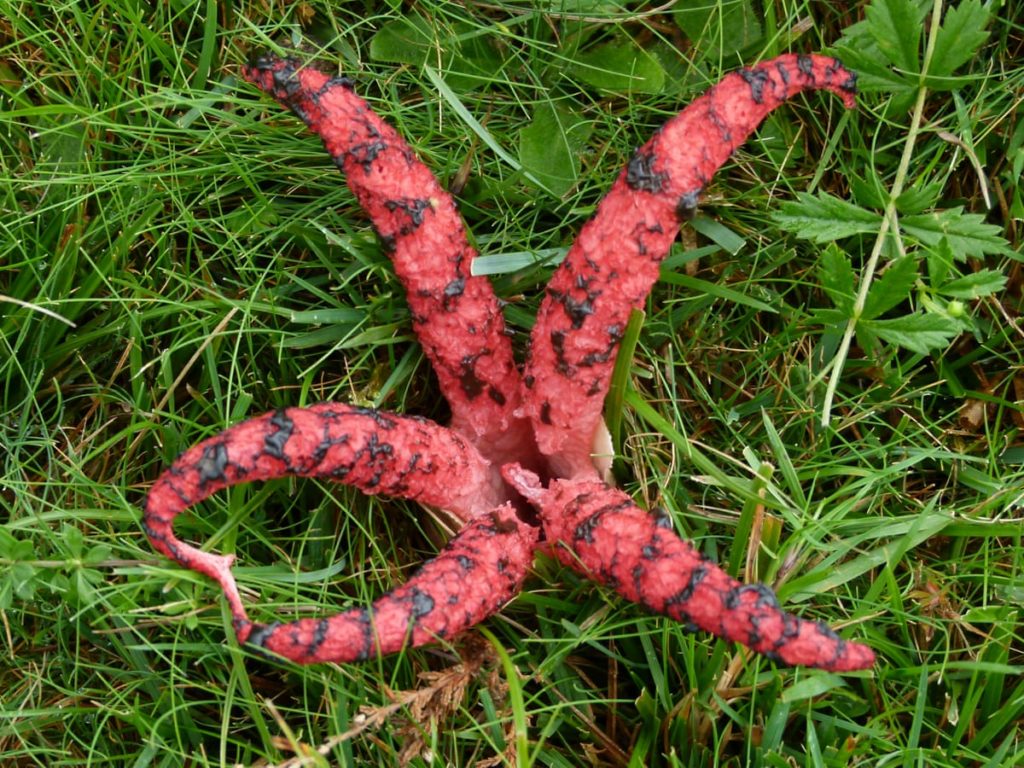

16. Schizophyllumcommune (Spilt-gill mushroom)
Schizophyllum commune is a species of fungus in the genus Schizophyllum. It obtains its common name “Split-gill” mushroom due to the unique longitudinally divided nature of the “gills” on the underside of the cap. The gills, which produce basidiospores on their surface, split when the mushroom dries out. These tough fungi occur throughout the world and are found in the wild on decaying trees and dead wood including cut timber, after rainy seasons followed by dry spells.
The mushroom has the appearance of undulating waves of tightly packed corals or loose Chinese fan, and it grows in shelf-like arrangements, without stalks. Its color varies from creamy yellow to pale white. The cap is small, 1 – 4 cm (0.4 – 1.6 in) wide with a dense yet spongey body texture. Schizophyllum commune is known for its high medicinal value and aromatic taste profile. The species is regarded as nonpoisonous, but considered as inedible due to its to smallness and toughness. However, since 2006, it has been widely consumed in Mexico and elsewhere in the tropics, as tough, rubbery mushrooms are prefered and conserved better in hot humid conditions compared to tender, fleshy mushrooms.
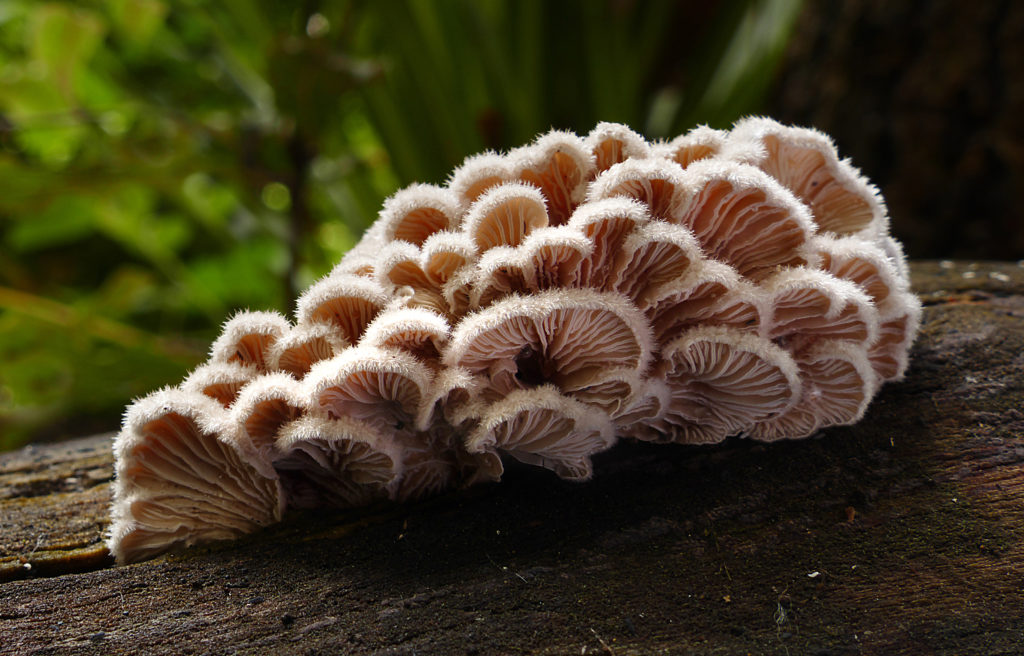
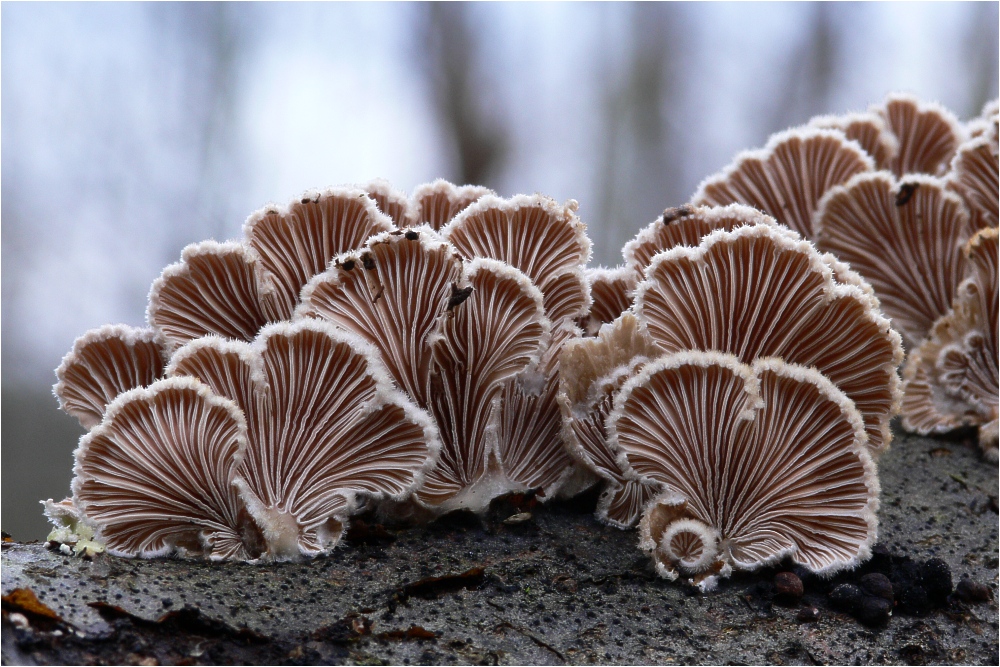
17. Clathrus ruber (Basket stinkhorn)
Clathrus ruber is a species of fungus in the family Phallaceae, and the type species of the genus Clathrus. It is known by its common names the latticed stinkhorn, the basket stinkhorn, or the red cage, referring to the round or oval-shaped hollow fruit bodies with interlaced or latticed branches. The fungus is saprobic, often found alone or in small groups in parks and gardens, beside decomposing vegetable matter and compost heaps, where they feeddecaying woody plant material. Clathrus ruber has a wide distribution across all continents except Antarctica.
Its initial appearance is that of a half-buried, roughly spherical whitish ball or ‘egg’ (up to 6 cm (2.4 in) in diameter) attached to the ground at the base by cords called rhizomorphs. A delicate, leathery outer membrane encloses the compressed lattice that surrounds a layer of olive-green spore-bearing slime (the gleba). This fungus cage-like form becomes apparent once the outer membrane of the egg bursts open. Spores are dispersed through flies and other insects that are attracted to the gleba that emits a foul-smelling odor like rotting meat.The fungus can reach heights of up to 20 cm (7.9 in) and has no stem. The color of the fruit body, ranging from pink to orange to red, is primarily caused by the carotenoid pigments lycopene and beta-carotene.
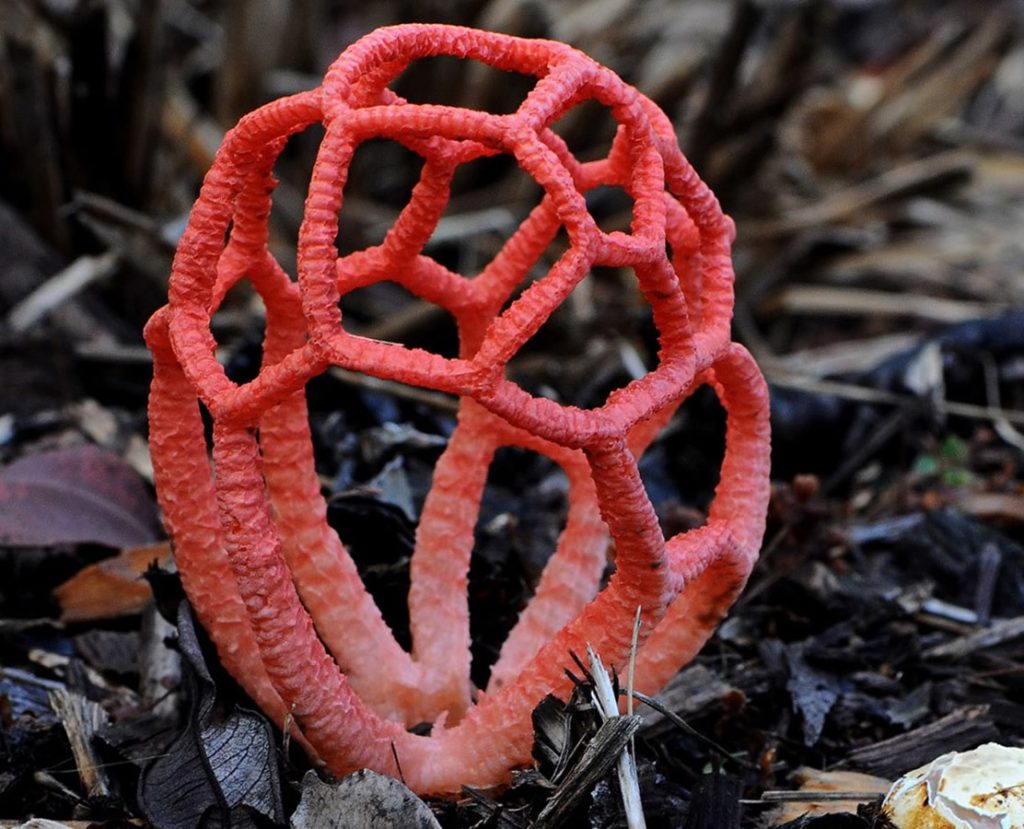

18. Geastrum triplex (Collared earthstar)
Geastrum triplex, known by its common names, collared earthstar, the saucered earthstar, or the triple earthstar, is the largest member of the genus Geastrum (earthstar fungi). The expanded mature specimens can reach a tip-to-tip length of up to 12 cm (4.7 in). The species is widespread and can be found in Asia, Australasia, Europe, and both North and South America.
Immature fruit bodies are spherical—somewhat resembling puffballs with pointed beaks—and are partially or completely buried in the ground. They are usually between 1 – 5 cm (0.4 to 2.0 in) in diameter, and up to 8 – 9 cm (3.1 to 3.5 in) broad after the rays have spread out. As the fungus matures, the outer layer of tissue (the exoperidium) separates into 4 – 8 pointed segments that stretch outwards and downwards, lifting and exposing the spherical inner spore sac containing the gleba.
Often, a layer of the exoperidium splits around the perimeter of the spore sac so that it appears to rest in a collar or saucer. Atop the spore sac, a pointed hole, known as the peristome, disperses the spores when the wind blows across it, or it gets struck by raindrops. The gleba is white and firm when young, but gradually turns into a dark brown powdery mass as the spores age. Geastrum triplex has a history of use in the traditional medicines of native North America and China.
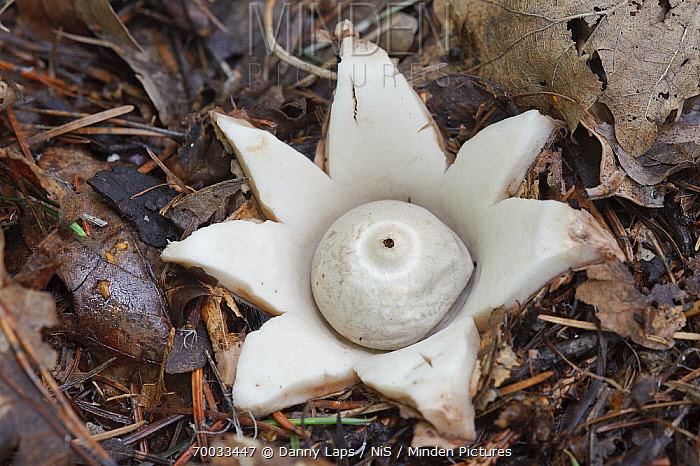

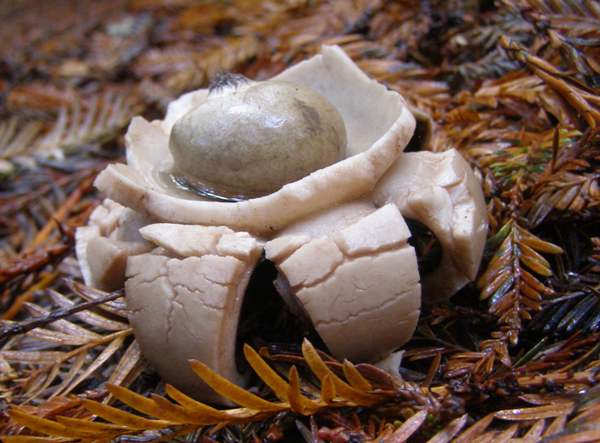
Read more articles:
- Silent Killers of the Sea: Fishing Nets and the Devastating Impact on Our Oceans
- Amazing Ability of Sharks to Regrow Their Dorsal Fins
- Mountain Marvels: 7 Architectural Wonders Built into Nature’s Slopes
- The Frilled Shark: Jaws of the Abyss and a Living Fossil
- 30 Christmas Rock Painting Ideas – Last minute DIY crafts for Christmas decor, gifts and stocking fillers

